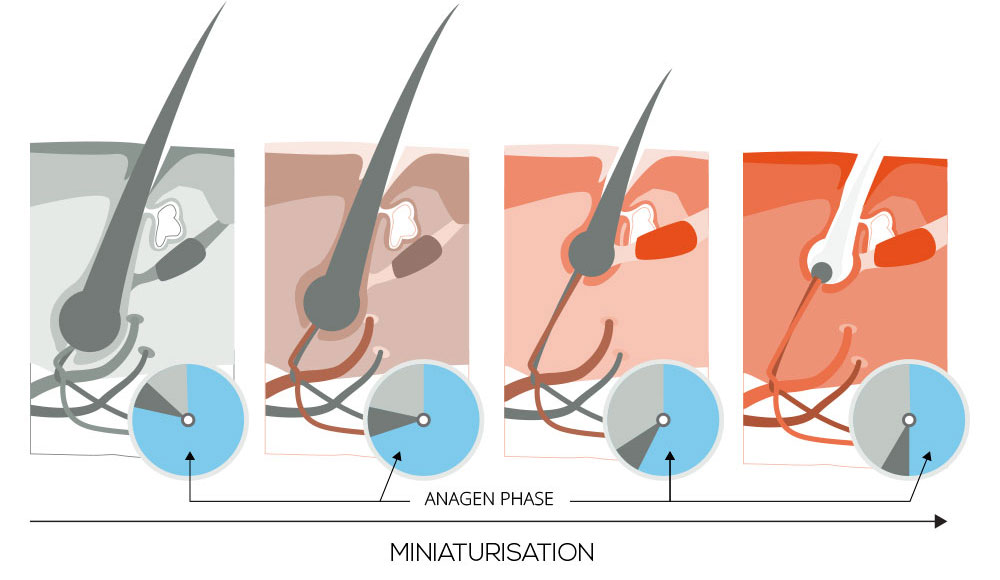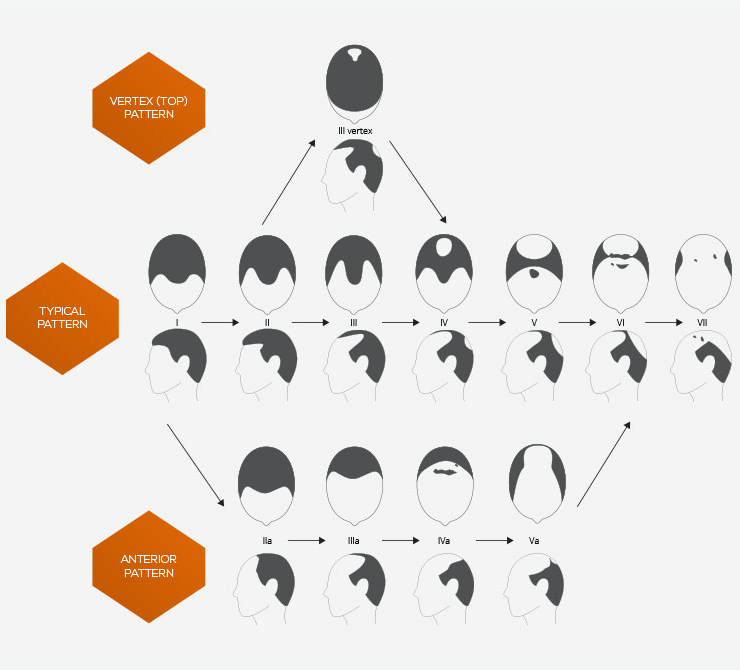How hair loss occurs
How hair grows | Male pattern baldness | Female pattern hair loss
Male pattern baldness
By far the most common form of hair loss is androgenic alopecia, which in men is known as male pattern baldness (MPB). It will affect up to 70% of men at some stage in their lifetimes, but in some men it can begin when they are very young: in their late teens or early twenties.
Male pattern baldness is most likely to affect men with a family history of hair loss. As boys reach puberty their levels of testosterone increase, including a testosterone derivative called dihydrotestosterone (DHT). Some men are genetically predisposed to be more sensitive to DHT. The effect is that the growth phase of the follicle lifecyle (anagen) becomes shorter and shorter, and the resting phase (telogen) becomes longer. The follicles shrink so that the hair becomes thinner and eventually unable to grow at all. This is known as follicular miniaturisation.
The miniaturising hair follicles can remain alive for some years, meaning that non-surgical treatments can slow or even reverse the effects of hair loss if applied sufficiently early. But once the follicles become dormant it is not possible to regrow the hair, and more advanced surgical techniques will be required to restore hair to the scalp.


The Norwood Scale of male pattern baldness
Male pattern baldness manifests itself in predictable ways. Hair at the sides and back of the scalp (the ‘safe donor zone’) usually continues growing for life, while hair loss almost invariably begins at the temples and then at the crown, leaving a ‘halo’ of hair which eventually recedes until there is full baldness on the top and front of the head.
The Norwood Scale was developed by Dr. O’Tar Norwood to identify how far a man has advanced in this process. Although the pattern is predictable, the rate at which different men lose their hair varies enormously. Some men may get to stage II or III in their twenties and then remain more or less at that level for decades, while others may show no discernible hair loss until middle age and then rapidly advance to stage VI or VII.

Stages of Male Pattern Baldness
Treating male pattern baldness
Although it is a very common condition, the psychological consequences of hair loss can be serious, affecting men’s confidence, self-esteem and even their relationships and careers.
Seeking treatment for male pattern baldness is perfectly normal, and today’s medication and surgical techniques mean that its effects can be successfully managed. Non-surgical treatments can allow men to enjoy a natural-looking head of hair for many years longer than would be the case if nature took its course, while surgical procedures can provide permanent solutions.
The earliest stage of male pattern baldness that tends to be suitable for treatment is stage III on the Norwood Scale, when there is noticeable loss at the temples. However, modern techniques such as those practised at The Maitland Clinic mean that great results can be achieved even when the hair loss is much more advanced.
The best candidates for hair transplant surgery tend to be those who have stabilised their hair loss using medication such as finasteride or minoxidil. Without this it can be difficult to restore the increasing areas of baldness with the limited donor hair supply at our disposal.
Types of Male Hairloss
Contact us
* Required fields










